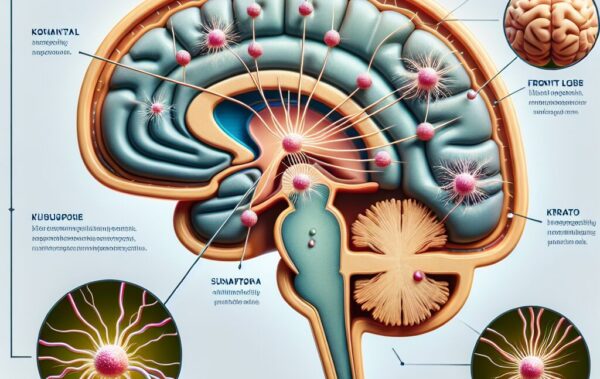Kratom, a herbal substance that has gained attention as an alternative to traditional painkillers, is derived from the leaves of Mitragyna speciosa, a tropical evergreen tree native to Southeast Asia. For centuries, it has been used in its indigenous cultures for various medicinal purposes. Farmers and laborers originally chewed the leaves or brewed them into a tea to combat fatigue and improve work productivity. Over time, the use of Kratom spread, and now it is being explored for its potential in providing alternative pain relief.
The active compounds in Kratom leaves, primarily mitragynine and 7-hydroxymitragynine, have been studied for their effects on the brain’s opioid receptors. Interestingly, these compounds are known to produce effects similar to both stimulants and opioids, depending on the dose administered. At lower dosages, Kratom can provide an energy boost and increase alertness, while higher doses may lead to sedative effects, which are specifically desired for pain management and alleviation from the discomfort associated with various conditions.
With the increasing prevalence of the opioid crisis, many are seeking non-traditional and less addictive means of managing pain. Kratom has thus found itself at the center of discussions as a possible substitute for opioids, which have caused widespread addiction and overdose deaths. However, it’s imperative to acknowledge that while Kratom has therapeutic potential, its legal status and safety profile continue to be debated among health professionals, regulatory agencies, and consumers themselves.
As the conversation around alternatives to opioid-based pain relief gains momentum, there is much to consider with respect to Kratom’s origins, applications, and the cultural context of its use. In traditional practice, the leaf is often consumed raw or as a tea; however, in recent years, the Western market has seen Kratom in various forms, such as powders, capsules, liquid shots, and even edibles.
Despite its potential, understanding Kratom’s origins and traditional uses is crucial for grasping its place in contemporary alternative medicine. The depth of historical use in Southeast Asia establishes a foundation from which further research and informed discussions can be built upon, thereby shaping the future of Kratom in the landscape of alternative pain relief options.
How Kratom compares to conventional painkillers
When examining Kratom as an alternative pain relief option, it’s essential to compare it directly to conventional painkillers, most notably opioids, which have long been the go-to solution for chronic and acute pain management in the West. What sets Kratom apart from these painkillers? It’s not just one, but a confluence of factors that make this herbal supplement stand out.
Firstly, Kratom does not belong to the opioid class of drugs, despite its ability to bind to the same brain receptors. Unlike opioids, which are synthetic or semi-synthetic substances that can lead to significant physical dependence and high potential for addiction, Kratom has a more complex pharmacological profile. Its primary alkaloids, mitragynine and 7-hydroxymitragynine, interact with opioid receptors, but they do so in a way that reportedly does not produce the same high level of dependency or risk of respiratory depression that is commonly associated with opioid overdoses.
Additionally, Kratom’s side effect profile is different. While conventional opioids often lead to side effects such as constipation, nausea, dizziness, and sedation, Kratom users report that, when taken responsibly, the side effects are generally milder and less debilitating. This, again, is dose-dependent, with lower doses of Kratom typically associated with stimulating effects and higher doses with sedative outcomes.
The diversity in strains and preparations of Kratom further sets it apart from traditional painkillers. There are numerous strains, such as Bali, Maeng Da, and Sumatra, each with varying levels of mitragynine and 7-hydroxymitragynine. This means that users can select a strain that caters best to their specific type of pain or desired effect.
Furthermore, the opioid crisis has underscored the urgent need for safer alternative pain management options. Opioids have been linked to a high risk of addiction and are responsible for a significant number of overdose-related deaths. Kratom, conversely, is being studied for its potential to help individuals wean off opioids due to its interaction with opioid receptors without the same high risk of life-threatening overdose.
In summary, while both Kratom and conventional painkillers may offer pain relief, Kratom provides a multifaceted approach with a different safety profile and legal status. Its unique mechanisms may present a lesser risk of dependence and fewer adverse effects when used appropriately. This doesn’t erase the concerns surrounding Kratom use but does emphasize the need for more comprehensive research and informed dialogue about its role in managing pain outside the purview of traditional opioids.
The potential benefits of Kratom for pain management
Nonetheless, beyond its distinct biochemical profile, the appeal of Kratom for pain management is beginning to capture the interest of those suffering from chronic pain, who find themselves searching for a reprieve that doesn’t tether them to the myriad of issues associated with long-term opioid use. This gradual shifting perspective brings us to the core of Kratom’s potential benefits in addressing pain without the harsh consequences that are so often coupled with traditional painkillers.
One of the primary benefits of Kratom, as anecdotally reported by users, is its efficacy in managing pain. Although individual experiences may vary, a significant number of users have voiced that even modest amounts of Kratom have provided them with substantial relief from chronic pain, which is frequently linked to conditions such as arthritis, fibromyalgia, and back pain. In certain preparations, like Maeng Da Kratom powder, which is known for its potent alkaloid content, users may discover a particularly effective ally in the struggle against discomfort.
Additionally, the alternative appeal of Kratom stands not just in its pain-relieving abilities but also in its potential to offer a holistic approach to well-being. With its dual-action as both a stimulant and a sedative, depending upon dosage, Kratom can also aid in enhancing mood and providing a sense of calmness, which can be particularly beneficial in the context of pain management, where psychological distress often exacerbates physical symptoms.
- Uncanny versatility in application, ranging from capsules for ease of use to Kratom tea for a ritualistic and soothing experience.
- Freedom of strain selection, allowing users to tailor their Kratom experience to personal pain management needs.
- Opportunities to blend Kratom with other natural remedies to potentiate effects and encourage a more comprehensive approach to health.
In-depth research and discussions on Kratom’s analgesic properties continue to unfold, leading to a wider acceptance in some parts of the world. Amidst the opioid crisis, there’s an emerging consensus that natural alternatives must be considered and valued as part of a sustainable and multifaceted strategy to combat chronic pain and reduce the dependency on traditional painkillers. It’s in this very discussion that Kratom carves out a significant place for itself as a viable option for pain management.
| Strain | Reported Benefits |
|---|---|
| Bali Kratom | Suitable for mild to moderate pain relief, with additional relaxing effects |
| Maeng Da Kratom | Highly potent, often utilized for its powerful analgesic and mood-elevating properties |
| Red Vein Kratom | Traditionally used for its sedative effects and as a nighttime pain relief |
As we continue to scrutinize the interconnection between Kratom’s potential benefits and the real-world implications of its use for pain, it’s clear that the herbal supplement doesn’t provide a one-size-fits-all solution. The considerations around dosage, strain specificity, and individual physiology all play critical roles in shaping its efficacy and safety profile. Despite the tangible promise Kratom holds, the utmost emphasis must be placed on responsible use, with a keen awareness of the legalities and clinical guidelines that dictate its application.
Kratom’s dialogue within the realm of alternative pain relief marks an important moment in our societal approach to managing chronic pain. Where traditional painkillers dominate, yet falter due to their propensity to cause addiction and other severe side effects, Kratom steps in as a multifaceted alternative. It serves not only as a substance that can potentially alleviate pain but as a symbol of the growing importance of integrating more natural and holistic remedies into our current healthcare model, particularly as we trudge through the opioid crisis.
Addressing the risks and concerns associated with Kratom use
 As we delve deeper into Kratom’s role as an alternative pain relief option, it is essential to address the inherent risks and concerns associated with its use. Kratom, like any substance ingested for medicinal purposes, can have a breadth of effects on the body and should be approached with a measure of caution.
As we delve deeper into Kratom’s role as an alternative pain relief option, it is essential to address the inherent risks and concerns associated with its use. Kratom, like any substance ingested for medicinal purposes, can have a breadth of effects on the body and should be approached with a measure of caution.
Foremost among these concerns are the risks associated with consuming unregulated substances. As Kratom is not currently approved by the FDA, there is no standardized oversight to guarantee the purity or dosage consistency of products available on the market. This raises the potential for adulteration with harmful substances or varying concentrations of active alkaloids, which can lead to unpredictable effects. However, some vendors, such as those found on our marketplace platform, commit to higher standards of quality and testing to ensure safer consumption.
Another significant worry is the potential for misuse and addiction. While many advocate Kratom as a safer alternative to traditional painkillers, particularly amidst the opioid crisis, there is still a possibility for dependence. Some users may develop a tolerance to Kratom with prolonged use, leading to the consumption of larger doses to achieve the same effect, which can spiral into a cycle of dependency. To mitigate this concern, responsible use guidelines emphasize the importance of regulating dosage and scheduling breaks to prevent tolerance build-up.
| Risk Factor | Concern |
|---|---|
| Regulatory Oversight | Lack of FDA approval means variable product quality and potential for adulterated substances |
| Dependency | Tolerance and potential withdrawal symptoms caution against unregulated or high-dose use |
| Interactions | Unknown interactions with prescription medications or other supplements can lead to adverse effects |
It is also paramount to discuss Kratom’s interactions with prescription medications and other supplements. Given that Kratom’s full pharmacological impact is still being uncovered, there is a significant gap in our knowledge regarding its interactions with other drugs. This could pose serious risks for individuals who might inadvertently mix Kratom with other medications, leading to dangerous side effects or diminished efficacy of their prescriptions.
When discussing Kratom usage, especially concerning pain management, one cannot overstate the need for individual caution. Every person’s biochemistry is different, creating a varied canvas of responses to Kratom. This can range from no effect at all to very pronounced pain relief, as well as unwanted side effects for some individuals. Side effects can include nausea, itching, dry mouth, and, in rare cases, more severe outcomes such as liver damage or exacerbated mental health conditions.
While many look to Kratom as an alternative to traditional painkillers, especially in the face of the opioid crisis, the diverse and complex nature of both pain and human physiology requires a careful and personalized approach to Kratom usage. The decision to use Kratom for pain management should always be taken in consultation with a healthcare professional, who can help navigate these concerns and evaluate the potential risks and benefits within the context of an individual’s overall health and treatment goals.
As we consider the convergence of potential benefits and inherent risks, it remains clear that substantial research is needed to fully understand both. Until such time as comprehensive clinical studies are performed and guidelines established, Kratom should continue to be approached with mindful deliberation, taking into account all known factors to make informed decisions about its use as an alternative option for managing pain.
Frequently asked questions about Kratom
As the dialogue surrounding Kratom continues, numerous questions arise from those exploring this botanical for alternative pain relief. Below, let’s answer some common inquiries regarding this increasingly popular herb:
Q: What exactly is Kratom, and how does it work for pain relief?
Kratom is a natural plant native to Southeast Asia, traditionally used for its energy-boosting and pain-alleviating properties. Its primary alkaloids, mitragynine and 7-hydroxymitragynine, interact with opioid receptors in the brain, which can lead to pain relief without the same level of risk associated with traditional painkillers.
Q: Is Kratom safe to use?
While Kratom is considered safe by many of its users, it is not regulated by the FDA. This means potential risks such as product adulteration or incorrect dosing. We recommend sourcing Kratom from reputable vendors who conduct rigorous testing.
Q: Can Kratom lead to addiction like opioids?
While Kratom has a lower risk of addiction compared to traditional opioids, there is still a potential for dependence, especially with long-term use. Responsible use, including controlled dosage and regular breaks, can help minimize these risks.
Q: Are there different strains of Kratom, and do they have different effects?
Yes, there are various strains of Kratom, each with distinct profiles and effects. For instance, Maeng Da is known for its strong analgesic properties, while Bali strains may offer a more balanced pain relief and relaxation. Selecting the appropriate strain is crucial to achieving desired outcomes.
Q: How do I determine the right dosage of Kratom?
Determining the right dosage of Kratom is personal and can depend on factors such as the specific pain being treated and individual physiology. Users often start with a low dose to assess tolerance and gradually increase as needed.
Q: How should Kratom be consumed?
Kratom can be consumed in various ways, including capsules, powders mixed into beverages, edibles, and more. Some users prefer Kratom tea for its natural and soothing form of ingestion.
Q: Is Kratom legal where I live?
The legality of Kratom varies by country and within the United States, by state. Always verify the current legal status of Kratom in your jurisdiction before purchasing or consuming it.
Q: Can Kratom impact mental health?
There is some evidence suggesting that Kratom might impact mood and mental health, potentially alleviating symptoms of anxiety or depression for some users. However, it may also worsen these conditions in others, so careful monitoring and consultation with a healthcare professional are advised.
Q: Where can I find reputable sources of Kratom?
For those looking to explore Kratom, you can find a variety of products on our marketplace platform, where vendors are committed to quality and safety.
This FAQ is by no means exhaustive but aims to address basic concerns and promote a more profound understanding of Kratom’s potential as an alternative pain relief solution. Given the ongoing opioid crisis, the continuing exploration into substances like Kratom is more pertinent than ever. By fostering informed discourse and responsible use, we empower individuals to make choices that align with their wellness goals while acknowledging the need for further research into the efficacy and safety of non-traditional remedies like Kratom.









